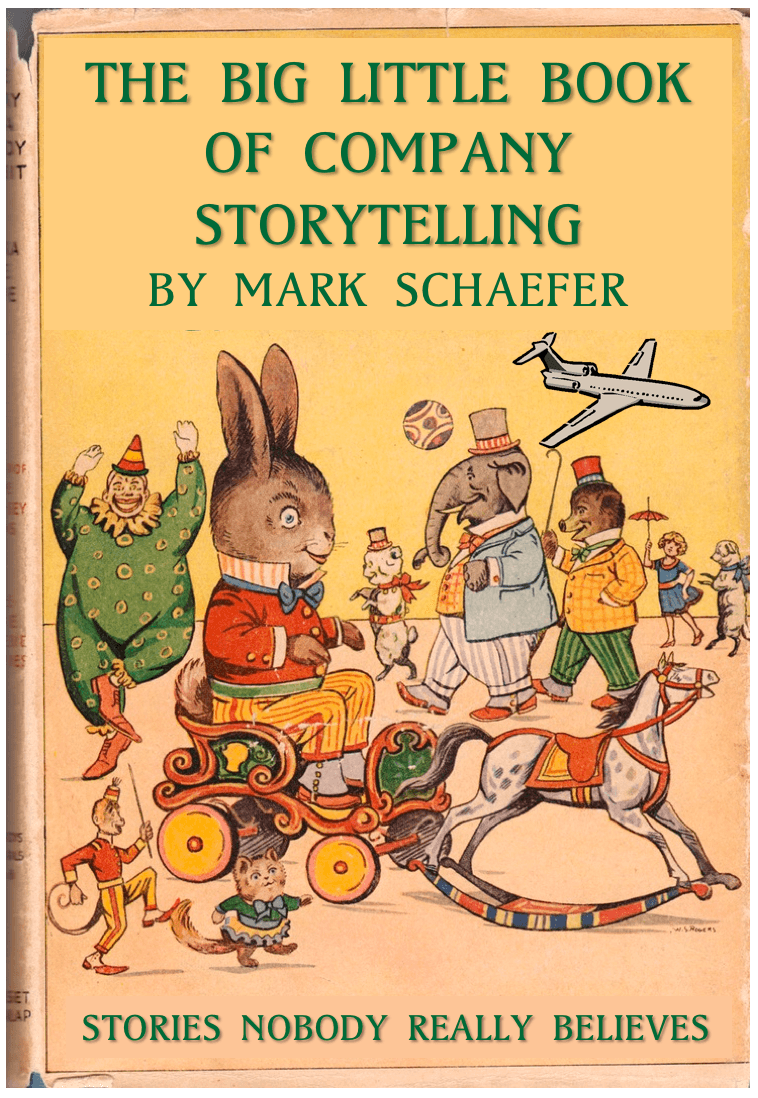
I realize this post contains a headline and theme that will not go over well with a lot of people, especially the thousands out there dedicated to selling the idea of corporate storytelling. And yet, it is a trend that must be discussed.
So, let’s gently ease into the topic … with a story of course.
I was on a cross-country flight and settled into my seat for an in-flight movie. I was on Delta Airlines, perhaps the least-shitty of America’s selection of shitty airlines, and before the movie, a “pre-roll” story ran promoting Delta’s values and vast civic involvement.
With breathless urgency a female voice exudes:
“You’re moving at the speed of the world! Look over, look down, and you’ll see it. Even when you’re sitting back, taking a break, catching your breath, pausing for a moment here in the clouds, you’re still going 500 miles an hour. But what does that mean? More than you can dream! Just by getting there, you — yes YOU! — are changing the world!
“Every Delta flight you catch has a butterfly effect. It starts with a click and launches a journey, turns profits into progress, gets into gear, pushes into spaces that connect people, not just destinations. That ticket in your pocket takes a dreamer to college, builds homes, habitats, playgrounds, and pride, honors heroes for their heroism, makes miracles from medicine, supports art that we can see through different eyes. (graphic: dozens of charity logos).
“We do more than fly planes. We make change. And everything we do is possible because of you.”

Love the matching outfits but I still don’t believe you Delta.
By the measure of most content marketers (and certainly the advertising agency that produced this video), this exhibits the hallmarks of excellent corporate storytelling, and undoubtedly made a lot of executives smile …
- It is beautifully produced
- It is emotional
- It features real people and real stories
- It connects the company to values and social good
- It even takes a stand on social issues (showing moments from a Gay Pride parade and the mention of “dreamers,” for example).
But here was my reaction as I watched this lovely video from my freezing-cold seat next to the screaming baby:
I.
DON’T.
CARE.
I just want to escape my exhausted airline reality and see the darn movie, and you’re interrupting me every time you play that video.
I sincerely do not believe you are The Great Charity In the Sky or that this insanely over-priced ticket in my pocket is “taking a dreamer to college.” I know deep down you’re only saying these things because you have to. Somehow this will nudge your stock price, somehow this will make you feel better about yourself as you check your “social good” box, and I simply do not trust you.
Even if you’re truly the Mother Teresa Airline and demonstrate that you’re benevolent and authentic and cool and pride-supporting and home-building, there are enough bad companies out there to make me group you with all the rest … and I’m sorry if I misjudged you, but that’s the way it is. In fact, the only businesses I trust are the ones making a difference and helping people in my local community.
If you really want to change the world Delta, serve me a free, hot meal on this six-hour flight, don’t squeeze me into a seat designed for Tyrion Lannister, and restore some dignity to the process of boarding a plane.
Let’s dig below the surface of this example. Am I just a grumpy frequent flyer, or are there clues to bigger consumer trends here?
Why is decent corporate “storytelling” so difficult — perhaps even outmoded — these days? Let’s look at the research …
1) Corporate storytelling is not believable
I recently browsed a site from one of the biggest corporate polluters in the world. It’s not that the company is inherently evil … they just have a process that requires stripping away virgin forests for their raw materials and then spewing volumes of chemicals into the air.
But if you look at their website, you would think they were Greenpeace or something — Whales leaping from the ocean! Fields of glorious daisies! Splashing waterfalls!
This is a phenomenon known as “greenwashing.” If we fill our sites with improbable stories of corporate benevolence and racially-diverse stock photos of people leaping in fields, maybe we can distract people from the reality.
Companies spin the truth. We have been thoroughly conditioned to not believe them, and this is reflected in research like the Edelman Trust Barometer which shows that trust in businesses has declined precipitously over time and now resides at an all-time low. This implies that no matter how hard you work on the “arc of your story,” people probably won’t trust it. I mean … whales? C’mon.
It’s one of the weirdest trends — companies are spending more on cause marketing, charitable giving is on the rise, social media has forced more transparency … and trust in corporations is going down.
It’s not that we don’t believe Delta Airlines. We don’t believe anybody preaching from an ivory tower.
Perhaps this is a reason some big brands are now easing out of corporate storytelling efforts.
2) Corporate storytelling isn’t native
Another reason corporate storytelling may not work anymore is because these tales rarely fit into the flow of a person’s native content stream.
Do this simple test. Quickly scroll through your Instagram feed without concentrating on the author and try to guess which photos are the sponsored content. I can do it almost every time without fail. Why? Because the sponsored pics stick out like a sore thumb — they still look like ads, not photos from our friends.
Most corporate content still looks like corporate content. As soon as my Spidey-senses detect even the lightest touch of PR-spin, a too-perfect photo of employees in matching outfits (right, Delta?), or writing that has been drained of life by the legal-approval strainer, the content is no longer content, it is an ad. You may call it a story but it is viewed as an ad.
And we generally don’t like ads. We avoid them, block them, skip them, walk out of the room to get a drink when they appear. So try as you might, most corporate storytelling is still an ad because it is not native to a person’s normal content experience.
3) If it’s not local, it’s suspicious
I recently heard a great presentation by Carla Buzasi, managing director for WGSN. Carla’s job is to find the mega-trends of the world and she recently reported on the idea that power in the world is shifting to “localvists.”

Buzasi
A localvist is somebody leading activism at a local level. Real activism.
We have been in a period of slacktivism where working for change meant “liking” the page of a social cause. But the localvists are fed up with our toxic and polarized world and have learned that they can work for real change.
This is not an age-related trend. It’s happening everywhere because there’s a feeling that there is a real possibility to create change in our world. This movement isn’t just aimed at governments — it’s also affecting banking, corporations, institutions and anybody else standing in the way of progress, inclusiveness, and personal freedom.
Of course, there have always been waves of activism in the world, but this is different because it is centered on change at a local level, with very different rules of engagement. Localvists don’t believe corporate stories because they don’t believe anything they can’t see happening on a local level. They have to witness the action in their community, not hear words from some faraway advertising agency.
In a sense, marketing must become artisanal. If you represent a brand people tangibly believe in, they are willing to fight for you and, according to Carla, even pay more for your product.
How does a global mega-brand like Delta Airlines become artisanal? Carla’s conclusion: “I don’t know,” she said in her company report. This is a hard problem.
So, what DOES work?
As I said at the beginning of the post, I realize this is a trend that many people will not want to acknowledge. Before you start dinging me with comments about all the wonderful storytelling success stories out there, allow me to soothe you by confirming that there will always be room for brand storytelling in some manner. It’s important.
However, I don’t think it can be over-emphasized that we’re in a period of dramatic and rapid change when it comes to consumer views of social media, content, and trust.
In the heart of the fake news era, we need to re-think how we tell our story, where we tell it, what we tell … and maybe even who tells it.
The research is undeniable and pervasive. Confidence in companies in America (and many other nations) is at an all-time low. Trust in anything that looks like an ad is even lower … if anybody even sees an ad any more.
However trust in people (friends, technical experts, subject authorities) is high, as explained in the same Edelman report.
Here’s what works today:
- User-generated content
- Employee-generated content (NOT necessarily advocacy programs)
- Reviews
- Influencers
- Experts and authorities
I recently wrote about an outstanding piece by North Face that completely flipped the normal corporate focus. Instead of telling the “corporate story,” it told their “customer story” through the voices of outdoor adventurers — an emotional and gritty video that enabled a sense of belonging.
Another interesting trend to watch is the rise in un-branded (or lightly-branded content) where the focus is truly on a story instead of a logo. We have spent our marketing lives in a culture wanting to “make the logo bigger” when our customers want the logo to go away.
The biggest danger right now is believing that progress means making incremental changes to what we did in our marketing departments last year. We need to heed the data, watch the trends carefully, and create highly-crafted, human, native content that is shared by real people.
Even if our product is not “artisanal” we need to “think artisanal” in our approach to corporate content going forward.
Your views?
 Mark Schaefer is the chief blogger for this site, executive director of Schaefer Marketing Solutions, and the author of several best-selling digital marketing books. He is an acclaimed keynote speaker, college educator, and business consultant. The Marketing Companion podcast is among the top business podcasts in the world. Contact Mark to have him speak to your company event or conference soon.
Mark Schaefer is the chief blogger for this site, executive director of Schaefer Marketing Solutions, and the author of several best-selling digital marketing books. He is an acclaimed keynote speaker, college educator, and business consultant. The Marketing Companion podcast is among the top business podcasts in the world. Contact Mark to have him speak to your company event or conference soon.


